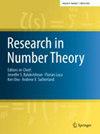下载PDF
{"title":"过配分函数的对数高阶差分不等式及王协章问题。","authors":"Gargi Mukherjee","doi":"10.1007/s40993-022-00420-y","DOIUrl":null,"url":null,"abstract":"<p><p>Let <math> <mrow><mover><mi>p</mi> <mo>¯</mo></mover> <mrow><mo>(</mo> <mi>n</mi> <mo>)</mo></mrow> </mrow> </math> denote the overpartition function. In this paper, our primary goal is to study the asymptotic behavior of the finite differences of the logarithm of the overpartition function, i.e., <math> <mrow> <msup><mrow><mo>(</mo> <mo>-</mo> <mn>1</mn> <mo>)</mo></mrow> <mrow><mi>r</mi> <mo>-</mo> <mn>1</mn></mrow> </msup> <msup><mi>Δ</mi> <mi>r</mi></msup> <mo>log</mo> <mover><mi>p</mi> <mo>¯</mo></mover> <mrow><mo>(</mo> <mi>n</mi> <mo>)</mo></mrow> </mrow> </math> , by studying the inequality of the following form <dispformula> <math> <mrow> <mtable> <mtr> <mtd><mrow><mo>log</mo> <mrow><mo>(</mo></mrow> <mn>1</mn> <mo>+</mo> <mstyle> <mfrac><mrow><mi>C</mi> <mo>(</mo> <mi>r</mi> <mo>)</mo></mrow> <msup><mi>n</mi> <mrow><mi>r</mi> <mo>-</mo> <mn>1</mn> <mo>/</mo> <mn>2</mn></mrow> </msup> </mfrac> </mstyle> <mo>-</mo> <mstyle> <mfrac><mrow><mn>1</mn> <mo>+</mo> <msub><mi>C</mi> <mn>1</mn></msub> <mrow><mo>(</mo> <mi>r</mi> <mo>)</mo></mrow> </mrow> <msup><mi>n</mi> <mi>r</mi></msup> </mfrac> </mstyle> <mrow><mo>)</mo></mrow> <mrow></mrow></mrow> </mtd> <mtd><mrow><mrow></mrow> <mo><</mo> <msup><mrow><mo>(</mo> <mo>-</mo> <mn>1</mn> <mo>)</mo></mrow> <mrow><mi>r</mi> <mo>-</mo> <mn>1</mn></mrow> </msup> <msup><mi>Δ</mi> <mi>r</mi></msup> <mo>log</mo> <mover><mi>p</mi> <mo>¯</mo></mover> <mrow><mo>(</mo> <mi>n</mi> <mo>)</mo></mrow> </mrow> </mtd> </mtr> <mtr> <mtd><mrow><mrow></mrow> <mrow></mrow> <mrow></mrow></mrow> </mtd> <mtd><mrow><mrow></mrow> <mo><</mo> <mo>log</mo> <mrow><mo>(</mo></mrow> <mn>1</mn> <mo>+</mo> <mstyle> <mfrac><mrow><mi>C</mi> <mo>(</mo> <mi>r</mi> <mo>)</mo></mrow> <msup><mi>n</mi> <mrow><mi>r</mi> <mo>-</mo> <mn>1</mn> <mo>/</mo> <mn>2</mn></mrow> </msup> </mfrac> </mstyle> <mrow><mo>)</mo></mrow> <mspace></mspace> <mtext>for</mtext> <mspace></mspace> <mi>n</mi> <mo>≥</mo> <mi>N</mi> <mrow><mo>(</mo> <mi>r</mi> <mo>)</mo></mrow> <mo>,</mo></mrow> </mtd> </mtr> </mtable> </mrow> </math> </dispformula> where <math><mrow><mi>C</mi> <mrow><mo>(</mo> <mi>r</mi> <mo>)</mo></mrow> <mo>,</mo> <msub><mi>C</mi> <mn>1</mn></msub> <mrow><mo>(</mo> <mi>r</mi> <mo>)</mo></mrow> <mo>,</mo> <mtext>and</mtext> <mspace></mspace> <mi>N</mi> <mrow><mo>(</mo> <mi>r</mi> <mo>)</mo></mrow> </mrow> </math> are computable constants depending on the positive integer <i>r</i>, determined explicitly. This solves a problem posed by Wang, Xie and Zhang in the context of searching for a better lower bound of <math> <mrow> <msup><mrow><mo>(</mo> <mo>-</mo> <mn>1</mn> <mo>)</mo></mrow> <mrow><mi>r</mi> <mo>-</mo> <mn>1</mn></mrow> </msup> <msup><mi>Δ</mi> <mi>r</mi></msup> <mo>log</mo> <mover><mi>p</mi> <mo>¯</mo></mover> <mrow><mo>(</mo> <mi>n</mi> <mo>)</mo></mrow> </mrow> </math> than 0. By settling the problem, we are able to show that <dispformula> <math> <mrow> <mtable> <mtr> <mtd> <mrow><munder><mo>lim</mo> <mrow><mi>n</mi> <mo>→</mo> <mi>∞</mi></mrow> </munder> <msup><mrow><mo>(</mo> <mo>-</mo> <mn>1</mn> <mo>)</mo></mrow> <mrow><mi>r</mi> <mo>-</mo> <mn>1</mn></mrow> </msup> <msup><mi>Δ</mi> <mi>r</mi></msup> <mo>log</mo> <mover><mi>p</mi> <mo>¯</mo></mover> <mrow><mo>(</mo> <mi>n</mi> <mo>)</mo></mrow> <mo>=</mo> <mstyle><mfrac><mi>π</mi> <mn>2</mn></mfrac> </mstyle> <mrow><mo>(</mo></mrow> <mstyle><mfrac><mn>1</mn> <mn>2</mn></mfrac> </mstyle> <msub><mrow><mo>)</mo></mrow> <mrow><mi>r</mi> <mo>-</mo> <mn>1</mn></mrow> </msub> <msup><mi>n</mi> <mrow><mfrac><mn>1</mn> <mn>2</mn></mfrac> <mo>-</mo> <mi>r</mi></mrow> </msup> <mo>.</mo></mrow> </mtd> </mtr> </mtable> </mrow> </math></dispformula>.</p>","PeriodicalId":43826,"journal":{"name":"Research in Number Theory","volume":"9 1","pages":"9"},"PeriodicalIF":0.6000,"publicationDate":"2023-01-01","publicationTypes":"Journal Article","fieldsOfStudy":null,"isOpenAccess":false,"openAccessPdf":"https://www.ncbi.nlm.nih.gov/pmc/articles/PMC9763134/pdf/","citationCount":"0","resultStr":"{\"title\":\"Inequalities for higher order differences of the logarithm of the overpartition function and a problem of Wang-Xie-Zhang.\",\"authors\":\"Gargi Mukherjee\",\"doi\":\"10.1007/s40993-022-00420-y\",\"DOIUrl\":null,\"url\":null,\"abstract\":\"<p><p>Let <math> <mrow><mover><mi>p</mi> <mo>¯</mo></mover> <mrow><mo>(</mo> <mi>n</mi> <mo>)</mo></mrow> </mrow> </math> denote the overpartition function. In this paper, our primary goal is to study the asymptotic behavior of the finite differences of the logarithm of the overpartition function, i.e., <math> <mrow> <msup><mrow><mo>(</mo> <mo>-</mo> <mn>1</mn> <mo>)</mo></mrow> <mrow><mi>r</mi> <mo>-</mo> <mn>1</mn></mrow> </msup> <msup><mi>Δ</mi> <mi>r</mi></msup> <mo>log</mo> <mover><mi>p</mi> <mo>¯</mo></mover> <mrow><mo>(</mo> <mi>n</mi> <mo>)</mo></mrow> </mrow> </math> , by studying the inequality of the following form <dispformula> <math> <mrow> <mtable> <mtr> <mtd><mrow><mo>log</mo> <mrow><mo>(</mo></mrow> <mn>1</mn> <mo>+</mo> <mstyle> <mfrac><mrow><mi>C</mi> <mo>(</mo> <mi>r</mi> <mo>)</mo></mrow> <msup><mi>n</mi> <mrow><mi>r</mi> <mo>-</mo> <mn>1</mn> <mo>/</mo> <mn>2</mn></mrow> </msup> </mfrac> </mstyle> <mo>-</mo> <mstyle> <mfrac><mrow><mn>1</mn> <mo>+</mo> <msub><mi>C</mi> <mn>1</mn></msub> <mrow><mo>(</mo> <mi>r</mi> <mo>)</mo></mrow> </mrow> <msup><mi>n</mi> <mi>r</mi></msup> </mfrac> </mstyle> <mrow><mo>)</mo></mrow> <mrow></mrow></mrow> </mtd> <mtd><mrow><mrow></mrow> <mo><</mo> <msup><mrow><mo>(</mo> <mo>-</mo> <mn>1</mn> <mo>)</mo></mrow> <mrow><mi>r</mi> <mo>-</mo> <mn>1</mn></mrow> </msup> <msup><mi>Δ</mi> <mi>r</mi></msup> <mo>log</mo> <mover><mi>p</mi> <mo>¯</mo></mover> <mrow><mo>(</mo> <mi>n</mi> <mo>)</mo></mrow> </mrow> </mtd> </mtr> <mtr> <mtd><mrow><mrow></mrow> <mrow></mrow> <mrow></mrow></mrow> </mtd> <mtd><mrow><mrow></mrow> <mo><</mo> <mo>log</mo> <mrow><mo>(</mo></mrow> <mn>1</mn> <mo>+</mo> <mstyle> <mfrac><mrow><mi>C</mi> <mo>(</mo> <mi>r</mi> <mo>)</mo></mrow> <msup><mi>n</mi> <mrow><mi>r</mi> <mo>-</mo> <mn>1</mn> <mo>/</mo> <mn>2</mn></mrow> </msup> </mfrac> </mstyle> <mrow><mo>)</mo></mrow> <mspace></mspace> <mtext>for</mtext> <mspace></mspace> <mi>n</mi> <mo>≥</mo> <mi>N</mi> <mrow><mo>(</mo> <mi>r</mi> <mo>)</mo></mrow> <mo>,</mo></mrow> </mtd> </mtr> </mtable> </mrow> </math> </dispformula> where <math><mrow><mi>C</mi> <mrow><mo>(</mo> <mi>r</mi> <mo>)</mo></mrow> <mo>,</mo> <msub><mi>C</mi> <mn>1</mn></msub> <mrow><mo>(</mo> <mi>r</mi> <mo>)</mo></mrow> <mo>,</mo> <mtext>and</mtext> <mspace></mspace> <mi>N</mi> <mrow><mo>(</mo> <mi>r</mi> <mo>)</mo></mrow> </mrow> </math> are computable constants depending on the positive integer <i>r</i>, determined explicitly. This solves a problem posed by Wang, Xie and Zhang in the context of searching for a better lower bound of <math> <mrow> <msup><mrow><mo>(</mo> <mo>-</mo> <mn>1</mn> <mo>)</mo></mrow> <mrow><mi>r</mi> <mo>-</mo> <mn>1</mn></mrow> </msup> <msup><mi>Δ</mi> <mi>r</mi></msup> <mo>log</mo> <mover><mi>p</mi> <mo>¯</mo></mover> <mrow><mo>(</mo> <mi>n</mi> <mo>)</mo></mrow> </mrow> </math> than 0. By settling the problem, we are able to show that <dispformula> <math> <mrow> <mtable> <mtr> <mtd> <mrow><munder><mo>lim</mo> <mrow><mi>n</mi> <mo>→</mo> <mi>∞</mi></mrow> </munder> <msup><mrow><mo>(</mo> <mo>-</mo> <mn>1</mn> <mo>)</mo></mrow> <mrow><mi>r</mi> <mo>-</mo> <mn>1</mn></mrow> </msup> <msup><mi>Δ</mi> <mi>r</mi></msup> <mo>log</mo> <mover><mi>p</mi> <mo>¯</mo></mover> <mrow><mo>(</mo> <mi>n</mi> <mo>)</mo></mrow> <mo>=</mo> <mstyle><mfrac><mi>π</mi> <mn>2</mn></mfrac> </mstyle> <mrow><mo>(</mo></mrow> <mstyle><mfrac><mn>1</mn> <mn>2</mn></mfrac> </mstyle> <msub><mrow><mo>)</mo></mrow> <mrow><mi>r</mi> <mo>-</mo> <mn>1</mn></mrow> </msub> <msup><mi>n</mi> <mrow><mfrac><mn>1</mn> <mn>2</mn></mfrac> <mo>-</mo> <mi>r</mi></mrow> </msup> <mo>.</mo></mrow> </mtd> </mtr> </mtable> </mrow> </math></dispformula>.</p>\",\"PeriodicalId\":43826,\"journal\":{\"name\":\"Research in Number Theory\",\"volume\":\"9 1\",\"pages\":\"9\"},\"PeriodicalIF\":0.6000,\"publicationDate\":\"2023-01-01\",\"publicationTypes\":\"Journal Article\",\"fieldsOfStudy\":null,\"isOpenAccess\":false,\"openAccessPdf\":\"https://www.ncbi.nlm.nih.gov/pmc/articles/PMC9763134/pdf/\",\"citationCount\":\"0\",\"resultStr\":null,\"platform\":\"Semanticscholar\",\"paperid\":null,\"PeriodicalName\":\"Research in Number Theory\",\"FirstCategoryId\":\"1085\",\"ListUrlMain\":\"https://doi.org/10.1007/s40993-022-00420-y\",\"RegionNum\":0,\"RegionCategory\":null,\"ArticlePicture\":[],\"TitleCN\":null,\"AbstractTextCN\":null,\"PMCID\":null,\"EPubDate\":\"\",\"PubModel\":\"\",\"JCR\":\"Q3\",\"JCRName\":\"MATHEMATICS\",\"Score\":null,\"Total\":0}","platform":"Semanticscholar","paperid":null,"PeriodicalName":"Research in Number Theory","FirstCategoryId":"1085","ListUrlMain":"https://doi.org/10.1007/s40993-022-00420-y","RegionNum":0,"RegionCategory":null,"ArticlePicture":[],"TitleCN":null,"AbstractTextCN":null,"PMCID":null,"EPubDate":"","PubModel":"","JCR":"Q3","JCRName":"MATHEMATICS","Score":null,"Total":0}
引用次数: 0
引用
批量引用


